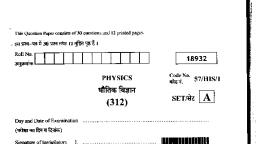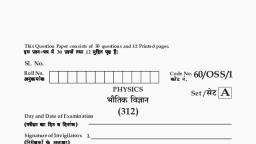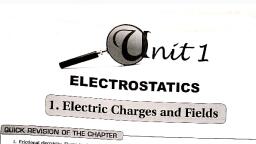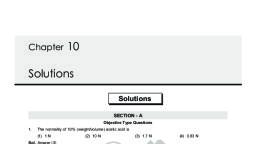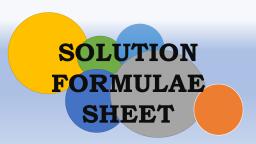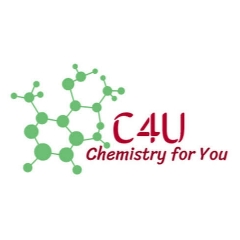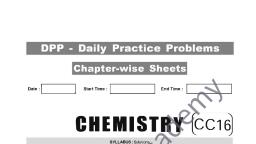Page 1 :
MODULE - 3, , Solutions, , States of matter, , 7, Notes, , SOLUTIONS, , You know that when sugar or salt is added to water, it dissolves. The resulting, mixture is called a solution. Solutions play an important role in our life. In industry,, solutions of various substances are used to carry out a large number of chemical, reactions., Study of solutions of various substances is very interesting., In this lesson, let us learn about the various components of a solution and the ways in, which concentration of solutions is expressed. We shall also learn about some properties, of solutions which are dependent only on the number of solute particles. (you will learn, about solute in this lesson), , OBJECTIVES, After reading this lesson, you will be able to:, z, , identify the components of different types of solution;, , z, , express the concentration of solutions in different ways;, , z, , list different types of solutions;, , z, , state Henry’s law;, , z, , define vapour pressure;, , z, , state and explain Raoult’s law for solutions;, , z, , define ideal solutions;, , z, , give reasons for non-ideal behaviour of solutions;, , z, , state reasons for positive and negative deviations from ideal behaviour;, , z, , explain the significance of colligative properties;, , CHEMISTRY, , 207
Page 2 :
MODULE - 3, States of matter, , Notes, , Solutions, z, , state reasons for the elevation of boiling point and depression in freezing point of, solutions;, , z, , explain the abnormal colligative properties;, , z, , define osmosis and osmotic pressure;, , z, , define Van’t Hoff factor;, , z, , correlate the degree of dissociation of solute and, , z, , solve numerical problems., , 7.1 COMPONENTS OF A SOLUTION, When we put sugar into water, it dissolves to form a solution. We do not see any more, sugar in it. Like sugar, a large number of other substances such as common salt , urea,, potassium chloride etc dissolve in water forming solution . In all such solutions , water, is the solvent and substances which dissolve are the solutes ., Thus, solute and solvent are the components of a solution . Whenever a solute mixes, homogeneously with a solvent , a solution is formed, solute + solvent → solution, A solution is a homogeneous mixture of two or more substances ., Solvent is that component of a solution that has the same physical state as the, solution itself., Solute is the substance that is dissolved in a solvent to form a solution., 7.1.1 The Concentration of a Solution, Some of the properties of solutions , e.g.. the sweetness of a sugar solution or the, colour of a dye solution , depend on the amount of solute compared to that of the, solvent in it. This is called the solution concentration . There are several ways, for describing concentration of solution . They include molarity, molality,, normality, mole fraction and mass percentage., Molarity: Molarity is defined as the number of moles of solute dissolved per, litre of solution and is usually denoted by M. It is expressed as :, M =, , n, V, , Where n is the number of moles of solute and V is the volume of the solution in, litres. A 2.0 molar solution of sulphuric acid would be labelled as 2.0 M H2SO4., , 208, , CHEMISTRY
Page 3 :
MODULE - 3, , Solutions, , It is prepared by adding 2.0 mol of H2SO4 to water to make a litre of solution., Molarity of a solution changes with temperature because of expansion or, contraction of the solution., , States of matter, , Molality : It is defined as the number of moles of solute dissolved per kilogram, of solvent., It is designated by the symbol m. The label 2.0 m H2SO4 is read “2 molal sulphuric, acid” and is prepared by adding 2.0 mol of H2SO4 to 1 kg of solvent. Molality is, expressed as:, m=, , Notes, , 1000 nB, WA, , where nB is the number of moles of the solute and WA is the mass in grams of, solvent. The molality of a solution does not change with temperature., Example 7.1 : Find out the molarity of the solution which contains 32.0 g of, methyl alcohol (CH3OH) in 200 mL solution., Solution : Molar mass of CH3OH = 12 + 1 × 3 + 16 + 1 = 32 g mol–1, Number of moles of CH3OH =, , 32 g, = 1 mol, 32 g mol –1, , Volume of the solution = 200 mL = 0.2 litre, ∴, , Molarity =, , 1, No. of moles of solute, =, =5M, 0.2, Volume of solution in litres, , Example 7.2 : What is the molality of a sulphuric acid solution of density 1.20, g/cm3 containing 50% sulphuric acid by mass., Solution : Mass of 1cm3 of H2SO4 solution = 1.20 g, Mass of 1 litre (1000 cm3) of H2SO4 solution = 1.20 × 1000 = 1200 g, Mass of H2SO4 in 100 g solution of H2SO4 = 50 g, Mass of H2SO4 in 1200 g solution of H2SO4 =, , 50, × 1200 = 600 g, 100, , ∴ Mass of water in the solution = 1200 – 600 = 600 g, Molar mass of H2SO4 = 98 g mol–1, No. of moles of H2SO4 =, , CHEMISTRY, , Mass in grams, 600 g, =, 98 g mol –1, Molar mass, , 209
Page 4 :
MODULE - 3, , Solutions, , States of matter, , No. of moles of H 2SO 4, Molarity = Mass of water in grams × 1000, , ∴, , =, , Notes, , 600, 1, ×, × 1000 = 6.8 m, 98, 600, , Normality : Normality is another concentration unit. It is defined as the number, of gram equivalent weights of solute dissolved per litre of the solution., The number of parts by weight of a substance (element or compound) that, will combine with or displace, directly or indirectly 1.008 parts by weight of, hydrogen, 8 parts by weight of oxygen and 35.5 parts by weight of chlorine, is known as equivalent weight. Like atomic weight and molecular weight,, equivalent weight is also a number and hence no units are used to express, it. However, when equivalent weight is expressed in grams, it is known as, gram equivalent weight of the substance., Equivalent weight =, , Atomic or molecular weight, Valency, , Equivalent weight of an acid =, , Molecular weight, Basicity, , Equivalent weight of a base =, , Molecular weight, Acidity, , Equaivalent weight of a salt =, , Molecular weight, Total valency of the metal atom, , oxidising and reducing agents may have different equivalent weights if they, react to give different products under different conditions. Thus, the equivalent, weight of such substances can be calculated from the reactions in which they, take part., Normality is denoted by the symbol N., ∴ Normality (N) =, , No. of gram equivalent weights of the solute, volume of the solution in litres, , =, , 1, Mass of the solute in grams, × volume of the solution in litres, Equivalent weight of the solute, , =, , Strength of solution in grams/litre, Equivalent weight of the solute, , The label 0.5 N KMnO4 is read “0.5 normal” and represents a solution which, contains 0.5 gram equivalent of KMnO4 per litre of solution., 210, , CHEMISTRY
Page 5 :
MODULE - 3, , Solutions, , Mole Fraction : The mole fraction of a component in a solution is the ratio of its, number of moles to the total number of moles of all the components in the solution., If a solution contains 2 mol of alcohol and 3 mol of water, the mole fraction of, alcohol is, , States of matter, , 2, 3, , and that of water . The sum of mole fractions of all the components, 5, 5, , of a solution is equal to one. The mole fraction (xA) of a component A in solution, with B is :, xA =, , Notes, , nA, nA + nB, , Where nA and nB are the number of the moles of A and B respectively., Mass Percentage : Mass percentage is the mass of solute present in 100 g of, solution. Thus 5% solution of KMnO4 in water means that 5 g of KMnO4 is, present in 100 g of the aqueous solution of KMnO4., Example 7.3 : A solution contains 36.0 g water and 46.0 g ethyl alcohol, (C2H5OH). Determine the mole fraction of each component in the solution., Solution : Molar mass of water = 18 g mol–1, Molar mass of C2H5OH = 46 g mol–1, No. of moles of water =, , 36 g, 18 g mol –1, , = 2.0 mol, , 46 g, , No. of moles of C2H5OH = 46 g mol –1 = 1.0 mol, Total number of moles in the solution = 2.0 + 1.0 = 3.0, Mole fraction of water =, , 2.0, No. of moles of water, =, = 0.67, Total no. of moles in the solution, 3.0, , Mole fraction of C2H5OH =, , 1.0, No. of moles of C2 H5 OH, =, = 0.33, Total no. of moles in the solution, 3.0, , Example 7.4 : Calculate the normality of a solution of NaOH if 0.4 g of NaOH, is dissolved in 100 ml of the solution., Solution : Mass of NaOH present in 100 mL of the solution = 0.4 g, ∴ Mass of NaOH present in 1000 mL of the solution =, , 0.4, × 1000 = 4.0 g, 100, , Mol. wt. of NaOH = 23 + 16 + 1 = 40 amu, , CHEMISTRY, , 211
Page 6 :
MODULE - 3, , Solutions, , States of matter, , Mol. Wt., , 4.0, , Eq. wt. of NaOH = Acidity =, = 40, 1, ∴ Normality =, , Notes, , Strength in g/litre, 4, 1, =, = N, Eq. wt., 40, 10, , Hence, the normality of the solution =, , 1, N or 0.1 N, 10, , INTEXT QUESTIONS 7.1, 1. List the various methods of expressing the concentration of a solution?, 2. Define the following, (i) Molarity, , (ii) Molality, , (iii) Normality, , 7.2 TYPES OF SOLUTIONS, Solutions can be solid, liquid or gaseous. Depending upon the physical state of, the solute and the solvent, there are nine possible types of solutions consisting of, two components (binary solutions) Different types of solutions are given in Table, 7.1., Table 7.1 Different Types of Solutions, SOLUTE, , SOLVENT, , SOLUTION, , Gas, , Gas, , Air, , Gas, , Liquid, , Soda water, , Gas, , Solid, , Hydrogen in palladium, , Liquid, , Gas, , Humidity in air, , Liquid, , Liquid, , Alcohol in water, , Liquid, , Solid, , Mercury in gold, , Solid, , Gas, , Camphor in air, , Solid, , Liquid, , Sugar in water, , Solid, , Solid, , Alloys such as brass (zinc in copper), and bronze (tin in copper), , Generally, we come across only the following three types of solutions:, (a) Liquids in Liquids: In the solution of liquids in liquids such as alcohol in, water, the constituent present in smaller amounts is designated as solute, and the constituent present in larger amounts is called the solvent. When, two liquids are mixed, three different situations may arise:, 212, , CHEMISTRY
Page 7 :
Solutions, , (i) Both the liquids are completely miscible, i.e., when, two liquids are mixed,, they dissolve in each other in all proportions, e.g., alcohol and water,, benzene and toluene., , MODULE - 3, States of matter, , (ii) The liquids are partially miscible, i.e., they dissolve in each other only to, a certain extent, e.g., water and phenol., (iii) The liquids are immiscible, i.e., they do not dissolve in each other, e.g.,, water and benzene, water and toluene., , Notes, , The solubility of liquids in liquids generally increases with rise in temperature., (b) Gases in Liquids: Gases are generally soluble in liquids. Oxygen is sufficiently, soluble in water, which allows the survival of aquatic life in ponds, rivers and, oceans. Gases like CO2 and NH3 are highly soluble in water. The solubility of a, gas in a liquid depends on the pressure, temperature and the nature of the gas, and the solvent. These factors are discussed below in detail :, (i) Effect of Pressure: The variation of solubility of a gas in a liquid with pressure, is governed by Henry’s law. Henry’s law states that, The mass or mole fraction, of a gas dissolved in a solvent is directly proportional, to the partial pressure of the gas., Henry’s law is represented by, x = Kp, where K is a constant, p is the partial pressure of the gas and x is the mole fraction of, the gas in the solution. Let us now see what are the conditions for the validity of, Henry’s law., (i), , Conditions for validity of Henry’s law: It is found that gases obey Henry’s, law under the following conditions., (i) the pressure is not too high., (ii) the temperature is not too low., (iii) the gas does not dissociate, associate or enter into any chemical reaction, with the solvent., , (ii) Effect of temperature: The solubility of a gas in a liquid at constant pressure, decreases with rise in temperature. For example, the solubility of CO2 in water, at 20°C is 0.88 cm3 per cm3 of water, where as it is 0.53 cm3 per cm3 of, water at 40°C. This happens because on heating a solution, containing a, dissolved gas, some gas is usually expelled from the solution., (iii) Effect of the nature of the gas and the solvent: Gases like CO2, HCl and,, NH3 are highly soluble in water where as H2, O2 and N2, are sparingly soluble., , CHEMISTRY, , 213
Page 8 :
MODULE - 3, , Solutions, , States of matter, , (c) Solids in liquids: When a solid is dissolved in a liquid, the solid is referred as the, solute and the liquid as the solvent. For example, in a solution of sodium chloride, in water, the solute is sodium chloride and water is the solvent. Different substances, dissolve to different extent in the same solvent., , 7.3 VAPOUR PRESSURE, Notes, , If we keep an inverted beaker over a small beaker containing a pure liquid, it is found, that the molecules of the liquid start evaporating in the form of vapours and fill the, empty space above the beaker containing the liquid. A time comes when the number, of molecules evaporating per unit time is equal to the number of molecules condensing, during that time (Fig. 7.1). An equilibrium is thus established between the vapour and, the liquid phase. The pressure exerted by the vapour of the liquid in such a case is, called the vapour pressure of the liquid., , Fig.7.1 : Vapour pressure of a liquid, , 7.4, , RAOULT’S LAW FOR SOLUTIONS, , Did you ever think that if you mix two miscible volatile liquids A and B, what would be, the vapour pressure of the resulting solution? The relationship between vapour pressure, of a liquid and its mole fraction is given by Raoult’s law., Raoult’s law states that for a solution of volatile liquids, the partial vapour pressure of, each liquid in the solution is directly proportional to its mole fraction., ., Raoult’s law is applicable only if the liquids are miscible. The vapour phase now consists, of vapours of both the liquids A and B. The partial vapour pressure of each liquid will, depend upon its mole fraction in the solution. Let the mole fractions of the liquids A, and B be XA and XB respectively. Also, if PA and PB are the partial vapour pressures of, A and B respectively, then, PA ∝ XA or PA = P0 A XA, Similarly,, , PB = p0 B XB, , where pA0 and pB0 represent the vapour pressures of pure liquids A and B respectively., , 214, , CHEMISTRY
Page 9 :
MODULE - 3, , Solutions, , If the values of PA and PB are plotted against the values of XA and XB for a solution,, two straight lines are obtained as shown in Fig. 7.2 the total vapour pressure P of the, solution is given by the sum of partial vapour pressures PA and PB., , States of matter, , Thus,, P = PA + PB, p = p 0A XA + pB0 XB, , or, , Notes, , The total vapour pressure (P) of a solution is represented by the line joining p 0A, and p0B. The solutions which obey Raoult’s law are known as ideal solutions., A solution which obeys Raoult’s law over the entire range of concentration, at all temperatures is called an ideal solution., pB0, p = pA, , + pB, , pB, , 0, , pB, , pA, , Vapour pressure, , pA, , XA = 1, XB = 0, , pA, , p = pA + pB, Mole fraction, , XA = 0, XB = 1, , Fig. 7.2 : Relationship between vapour pressure and mole fraction in a solution, , INTEXT QUESTIONS 7.2, 1. State Raoult’s law., 2. State Henry’s law and list the conditions necessary for the validity of Henry’s, law, , 7.5 RAOULT’S LAW FOR SOLUTIONS CONTAINING, NON-VOLATILE SOLUTE, If we have an aqueous solution containing a non-volatile solute, such as sugar or, salt, what do you think about the vapour pressure exerted by such a solution?, The vapour phase of such a solution consists of vapours of solvent (A) only, because the solute is non-volatile. Since the mole fraction of the solvent in solution, is less than one, therefore according to RaouIt’s law, the vapour pressure of the, CHEMISTRY, , 215
Page 10 :
MODULE - 3, States of matter, , Solutions, , solution will be less than the vapour pressure of the pure solvent. If the total vapour, pressure of the solution is P, then, PA = pA0 XA, , ...(7.1), , for a binary mixture, XA + XB = 1, Notes, , therefore,, XA = 1 – XB, Substituting the value of XA in equation (7.1) we get, PA = p0A(1 – XB), PA, PA0, , therefore,, , p0A − p A, PA0, , = 1 – XB, = XB, , In the above equation, (P0A – PA) represents the lowering of the vapour pressure, and, , p0A − p A, PA0, , is called the relative lowering of the vapour pressure of the solution., , An alternative statement of Raoult’s law for solutions of non-volatile solute is :, The relative lowering of vapour pressure for a solution is equal to the mole, fraction of the solute, when only the solvent is volatile., , 7.6 IDEAL AND NON-IDEAL SOLUTIONS, Ideal solutions obey Raoults Law and during their formation there is no, change in heat and volume., Non-ideal solutions are those solutions which do not obey Raoult’s law and, whose formation is accompanied by changes of heat and volume., Most of the real solutions are non-ideal. They show considerable deviation from, the ideal behaviour. Generally deviations are of two types;, (i) Positive deviation: Positive deviations are shown by liquid pairs for which the, A-B molecular interactions are weaker than the A-A and or B-B molecular interactions., The total vapour pressure for such solutions is greater than predicted by RaouIts law., The total vapour pressure for such a solution will be maximum for a particular, intermediate composition (Fig. 7.3), Examples of non-ideal solutions showing positive deviation from the ideal, behaviour are mixtures of liquids such as water-propanol, ethanol-chloroform,, acetone- carbon disulfide, ethanol-cyclohexane etc., 216, , CHEMISTRY
Page 11 :
MODULE - 3, , Solutions, , States of matter, pB0, , p, p = pA + B, , pA0, , pB, , Vapour pressure, , pA, pB, , pA, , Notes, , Mole fraction, , XA = 1, XB = 0, , XA = 0, XB = 1, , Fig. 7.3 : Positive deviation for a liquid pair, , (ii) Negative Deviation: Negative deviations are shown by liquid pairs for which the, A-B molecular interactions-are stronger than A-A or B-B molecular interactions. The, total vapour pressure for such solutions is less than that predicted by Raoult’s law. For, a particular intermediate composition, the total vapour pressure of such a solution will, be minimum (Fig. 7.4). Examples of such liquid pairs are chloroform acetone, watersulphuric acid, phenol-aniline, water- HCI etc., pB0, p = pA +, , Vapour pressure, , pA0, , pB, , pB, , pA, , pB, , XA = 1, XB = 0, , pA, , Mole fraction, , XA = 0, XB = 1, , Fig. 7.4 : Negative deviation for a liquid pair, , 7.7, , COLLIGATIVE PROPERTIES, , Do you know that there are certain properties of dilute solutions which depend only, on the number of particles of solute and not on the nature of the solvent and the solute?, Such properties are called colligative properties. There are four colligative properties, : relative lowering of vapour pressure, elevation in boiling point, depression in freezing, point and osmotic pressure., We shall discuss these colligative properties in detail in the following sections., , CHEMISTRY, , 217
Page 12 :
MODULE - 3, States of matter, , Solutions, , 7.7.1 Relative Lowering of Vapour Pressure, According to Raoult’s law for solutions containing non- volatile solute, Ρ 0A − PA, , = XB (see section 7.5), , PA0, , Notes, , ...(i), , nB, , Also, , XB = n + n, A, B, , In a dilute solution nB << nA Therefore the term nB can be neglected in the, denominator., , Hence,, , XB, , WB, nB M B, W .M, = n =W = B A, A, WA . M B, A, MA, , Therefore equation (i) can be written as, Ρ0A − Ρ A, Ρ0A, , WB . M A, , = XB = W . M, A, B, , The above expression can be used to determine the molecular mass of the solute, B, provided the relative lowering of vapour pressure of a solution of known, concentration and molecular mass of the solvent are known. However, the, determination of molecular mass by this method is often difficult because the, accurate determination of lowering of vapour pressure is difficult., Example 7.5: The relative lowering of vapour pressure produced by dissolving, 7.2 g of a substance in 100g water is 0.00715. What is the molecular mass of the, substance?, Solution: We know that, PA0 − PA, PA0, , W, , M, , B, A, = M ×W, B, A, , Substituting the values we get, 7.2 × 18, , 0.00715 = M × 100, B, ∴, 218, , 7.2 × 18, , or MB = 0.00715 × 100, , Molecular mass of the substance = 181.26 amu, CHEMISTRY
Page 13 :
MODULE - 3, , Solutions, , States of matter, , 7.7.2 Elevation of Boiling Point, Boiling point of a liquid is the temperature at which the vapour pressure of the liquid, becomes equal to the atmospheric pressure., As you know, the vapour pressure of a pure solvent is always higher than that of its, solution. So, the boiling point of the solution is always higher than that of the pure, solvent. If you see the vapour pressure curves for the solvent and the solution (Fig., 7.5), you will find that there is an elevation in the boiling point of the solution., , Notes, , Vapour pressure, , 1 Atmosphere, , Sol, , ven, , t, , tion, , Solu, , DTb, , B.P. of, solvent, , Temperature K, , B.P. of, solution, , Fig. 7.5 : Vapour pressure curves for solvent and solution, , Now let ΔTb be the elevation in boiling point and Δp be the lowering in vapour pressure., Then,, ΔTb α Δp α XB or ΔTb = K XB, , (i), , K is the proportionality constant, As you know, , nB, , XB = n + n, A, B, , In a dilute solution, nB << nA and thus the term nB is neglected in the denominator., , Thus,, , XB =, , nB, nA, , WB, WB, MA, MA, M, = B = M × W = nB × W, WA, B, A, A, MA, , Substituting the value of XB in the equation (i) we get, MA, , ΔTb = K × nB × W, A, CHEMISTRY, , 219
Page 14 :
MODULE - 3, , Solutions, , States of matter, , If we take the mass of the solvent WA in kilograms the term, , nB, is molality m. Thus, WA, , ΔTb = K MA . m = KB m, , Notes, , The constant Kb is called the molal elevation constant for the solvent. Kb may be, defined as the elevation in boiling point when one mole of a solute is dissolved, in one kilogram of the solvent. Kb is expressed in degree per molality., 7.7.3 Depression in Freezing Point, Freezing point is the temperature at which the solid and the liquid forms have the same, vapour pressure, , Vapour pressure, , The freezing point of the solution is always less than that of the pure solvent. Thus,, there is a depression in the freezing point of the solution This is because the vapour, pressure of the solution is always less than that of the pure solvent., , Solven, , l, So, , id, , S, , ve, ol, , t, , nt, , Solutio, , n, , DTf, , FP of FP of, solution solvent, , Temperature K, , Fig. 7.6 : Vapour pressure curves for solid, solvent and solution, , Let ΔTf be the depression in freezing point. Then:, ΔT f α XB, or, , ΔT f = KXB, , ...(ii), , Where K the proportionality constant, You know that, , nB, , XB = n + n, A, B, , In dilute solutions nB << nA, Therefore, the term nB can be neglected from the denominator. Thus,, , 220, , CHEMISTRY
Page 15 :
MODULE - 3, , Solutions, , States of matter, , n, W / MB, M, W, M, XB = B = B, = B × A = nB × A, MB, WA, WA, nA WA / M A, ⎛, WB ⎞, ⎜ sin ce n B =, ⎟, MB ⎠, ⎝, , Substituting the value of XB in equation (ii) we get, MA, , ΔTf = K × nB × W, A, , Notes, nB, , If the mass of the solvent WA is taken in kg, then the term W becomes, A, molality m., Thus,, , ΔTf = K MA . m = Kf . m, , The constant (Kf ) for a solution is known as molal depression constant or, molal cryoscopic constant for the solvent. Kf may be defined as the depression, in freezing point of a solution when one mole of a solute is dissolved in 1, kilogram of the solvent., Example 7.6: Find the (i) boiling point and (ii) freezing point of a solution, containing 0.520 g glucose (C6H12O6) dissolved in 80.2g of water.(Kf = 1.86 K/, m, Kb = 0.52 k/m.), Solution:, , Molality of glucose =, , =, , Wt. of glucos e, 1000, ×, mol. Wt., Wt. of solvent, , 0.52 1000, ×, = 0.036, 180 80.2, , ΔTb = Kbm = 0.52 × 0.036 = 0.018 K, ∴, (ii), , Boiling point = 373 + 0.018 = 373.018 = 373.02 K, Kf = 1.86 K/m, m=, , 0.52 1000, ×, = 0.036, 180 80.2, , ∴, , ΔTf = 1.86 × 0.036 = 0.66 K, , ∴, , Freezing point = 273 – 0.66 = 272.34 K, , 7.7.4 Osmosis and Osmotic Pressure, You must have observed that if rasins are soaked in water for some time, they, swell. this is due to the flow of water into the rasins through its skin which acts, , CHEMISTRY, , 221
Page 16 :
MODULE - 3, States of matter, , Notes, , Solutions, , as a semipermeable membrane (permeable only to the solvent molecules). This, phenomenon is also observed when two solutions of different concentrations in, the same solvent are separated by a semipermeable membrane. In this case the, solvent flows from a solution of lower concentration to a solution of higher, concentration. The process continues till the concentrations of the solutions on, both sides of the membrane become equal., The spontaneous flow of the solvent from a solution of lower concentration (or pure, solvent) to a solution of higher concentration when the two are separated by a, semipermeable membrane is known as osmosis., The flow of solvent into the solution of higher concentration from a solution of lower, concentration (on pure solvent) can be stopped if some extra pressure is applied to, that side of the solution which has a higher concentration. The pressure that just stops, the flow of the solvent is called osmotic pressure., Thus, osmotic pressure may be defined as the excess pressure that must be applied, to the solution side to just prevent the passage of pure solvent into it when the, two are seprated by a perfect semipermeable membrane. This is illustrated in, Fig. 7.7., h, , Solvent, Solution, Semipermeable, membrane, , Fig. 7.7 : Osmosis, , The pressure that must be applied to the solution side to prevent it from rising in the, tube is the osmotic pressure. It is also equal to the hydrostatic pressure of the liquid, column of height h., If the two solutions have the same osmotic pressure, they are known as isotonic, solutions. The osmotic pressure is a colligative propertly. It depends on the number, of particles of solute present in the solution and not on their nature. At a given, temperature T, the osmotic pressure (π) of a dilute solution is experimentally, found to be proportional to the concentration of the solution in moles per litre., Mathematically,, , π = CRT, , where π is the osmotic pressure and R is the gas constant, or, , π=, , nB, RT, V, , where nB is the number of moles of solute present in V litres of the solution, 222, , CHEMISTRY
Page 17 :
MODULE - 3, , Solutions, , States of matter, , or, , w, , πV = M, RT, solute, , where w in the mass of solute dissolved in V litres of the solution and Msolute is, the molar mass of the solute. Thus, knowing π, V and w, the molar mass of the, solute can be calculated., Thus, the molar masses of the solutes can be determined by measuring the osmotic, pressure of their solutions. This method has been widely used to determine the, molar masses of macromolecules, proteins, etc., which have large molar masses, and limited solubility. Therefore their solutions have very low concentrations, and the magnitudes of their other colligative properties are too small to measure., yet their osmotic pressures are large enough for measurements. As the osmotic, pressure measurements are done at around room temperature, this method is, particularly useful for determining the molar masses of biomolecules as they are, generally not stable at higher temperature., , Notes, , Example 7.7 : The osmotic pressure of an aqueous solution of a protein containing, 0.63 g of a protein in 100 g of water at 300 K was found to be 2.60 × 10–3 atm., Calculate the molar mass of the protein. R = 0.082 L atm K–1 mol–1., We know that osmotic pressure of a solution in given by the expression, w, , πV = M, RT, solute, or, , Msolute =, , w, RT, πV, , Substituting the values, we get, Msolute =, , (0.63g) × (0.082 L – atm K –1mol –1 ) × (300 K), (2.60 × 10−3 atm) × (0.100 L), , = 61022 g mol–1, Thus, molar mass of the protein is 61022 g mol–1., Reverse Osmosis and Water Purification, If a pressure higher than the osmotic pressure is applied to the solution side, the, direction of flow of the solvent can be reversed. As a result, the pure solvent, flows out of the solution through the semipermeable membrane. This process is, called reverse osmosis. It is of great practical application as it is used for, desalination of sea water to obtain pure water., , CHEMISTRY, , 223
Page 18 :
MODULE - 3, , Solutions, , States of matter, , INTEXT QUESTIONS 7.3, 1. Define colligative property. List two colligative properties., 2. What type of liquid pairs show (i) positive deviations (ii) negative deviations., Notes, , 3. Why is the determination of osmotic pressure a better method as compared to, other colligative properties for determining the molar masses of biomolecules., , 7.8, , ABNORMAL COLLIGATIVE PROPERTIES, , The colligative properties of the solutions depend only upon the number of solute, particles present in the solution and not on their nature But sometimes while measuring, colligative properties abnormal results are obtained due to the following reasons :, (i), , If the solution is very concentrated, the particles of the solute start interacting, with each other. Therefore, the solution should not be concentrated., , (ii), , In case of association two or more solute molecules associate to form a bigger, molecule. The number of effective molecules in the solution, therefore decreases., Consequently, the value of the collgative property (relative lowering of vapour, pressure, elevation of boiling point, depression of freezing point, osmotic pressure), is observed to be less than that calculated on the basis of unassociated molecules. Since, the colligative property is inversely proportional to the molar mass,, the molar mass of such solutes calculated on the basis of collgative property will, be greater than the true molar mass of the solute., , (iii) In case of dissociation of the solute in the solution, the number of effective, solute particles increases. In such cases the value of the observed collgative, property will be greater than that calculated on the basis of undissociated solute, particles. The molar mass of the solute calculated from the measurement of, collgative property will be lower than the true molar mass of the solute., Van’t Hoff factor, In order to account for extent of association or dissociation Van’t Hoff introduced a, factor ‘i’., i=, , Observed colligative property, Normal (calculated or expected) colligative property, , Since the colligative property is proportional to the number of solute particles or the, number of moles of solute, Total number of moles of solute in the solution, , i = Expected (calculated) number of moles of solute, 224, , CHEMISTRY
Page 19 :
MODULE - 3, , Solutions, , Also, since colligative properties vary inversely as the molar mass of the solute, it, follows that, i=, , States of matter, , Normal (calculated or expected) molar mass, Observed molar mass, , Here the observed molar mass is the experimentally determined molar mass whereas, the normal molar mass is the molar mass calculated on the basis of chemical formula of, the solute. In case of association the value of van’t Hoff factor, i, is less than unity while, for dissociation it is greater than unity. For example, benzoic acid associates in benzene, to form a dimer. The value of i is, therefore, close to 1/2. The value of i for aqueous, NaCl is close to 2.0 because NaCl dissociates in water to form Na+ and Cl– ions., , Notes, , The inclusion of van’t Hoff factor, i, modifies the equations for the colligative properties, as follows :, PA0 – PA, PA0, , = i XB, , ΔT b = i Kb m, ΔT f = i Kf m, , π V = i CRT, Degree of Association, Degree of association may be defined as the fraction of the total number of molecules, which associate to form a bigger molecule. Let us consider the association of benzoic, acid in benzene. In benzene two molecules of benzoic acid associate to form a dimer., It can be represented as, ZZX (C6H5COOH)2, 2C6H5COOH YZZ, , If x represents the degree of association of benzoic acid in benzene (i.e out of one, molecule of benzoic acid, x molecules associate to form a dimer), then at equilibrium., No. of moles of unassociated benzoic acid = 1 – x, No of moles of associated benzoic acid =, , x, 2, , Total number of effective moles of benzoic acid = 1 – x +, , CHEMISTRY, , x, x, =1–, 2, 2, , 225
Page 20 :
MODULE - 3, States of matter, , Solutions, , According to definition, Van’t Hoff factor is given by, Total number of moles of solute in the solution, i=, =, Expected (calculated) number of moles of solute, , Notes, , 1−, , x, 2, , 1, , Example 7.8 : Acetic acid (CH3COOH) associates in benzene to form double, molecules 1.60 g of acetic acid when dissolved in 100 g of benzene (C6H6) raised the, boiling point by 273.35 K. Calculate the van’t Hoff factor and the degree of association, of benzoic acid. Kb for C6H6 = 2.57 K kg mol–1., ΔTb = i kb m =, , Solution :, , 1000 i Kb WB, WA M B, , Normal molar mass (MB) of CH3COOH = 60 g mol–1, ΔTb × WA × M B, , Van’t Hoff factor, i, is = 1000 × K × W, b, B, , 0.35 × 100 × 60, , = 1000 × 2.57 × 1.60, = 0.51, Since, acetic acid associates in benzene to form double molecules, the following, equilibrium exists in the solution., ZZX (CH COOH), 2CH3COOH YZZ, 3, 2, , If x represents the degree of association of the solute, then we would have (1 –x) mol, of acetic acid left unassociated and x/2 moles of acetic acid at equilibrium., Therefore, total number of particles at equilibrium, , = 1 – x + x/2, = 1−, , x, 2, , The total number of partilces at equilibrium equal van’t Hoff factor. But van’t Hoff, factor (i) is equal to 0.51., ∴, , or, , 1−, , x, = 0.51, 2, x, = 1 – 0.51 = 0.49, 2, , x = 0.49 × 2 = 0.98, 226, , CHEMISTRY
Page 21 :
MODULE - 3, , Solutions, , States of matter, , Therefore, degree of association of acetic acid in benzene is 98%,., Degree of dissociation, Degree of dissociation may be defined as the fraction of the total number of particles, that dissociate, i.e., break into simpler ions. Consider a solution of KCl in water., When KCl is dissolved in water, it dissociates into K+ and Cl– ions., , Notes, , ZZX K+ + Cl–, KCl YZZ, , let x be the degree of dissociation of KCl, then at equilibrium, number of moles of, undissociated KCl = 1 – x, According to the dissociation of KCl shown above, when x mol of KCl dissociates,, x moles of K+ ions and x mol of Cl– ions are produces, Thus, the total number of moles in the solution after dissociation, =1–x+x+x=1+x, Hence,, , Total number of moles of solute in the solution, , i = Expected (calculated) number of moles of solute =, , 1+ x, 1, , Example 7.9 : A 0.5 percent aqueous solution of potassium chloride was found to, freeze at 272.76 K. Calculate the van’t Hoff factor and the degree of dissociation of, the solute at this concentration. (Kf for H2O = 1.86 K kg mol–1)., Solution : Normal molecular weight of KCl = 39 + 35.5 = 74.5 g mol–1, Observed molecular weight, MB =, , =, , 1000 × WB × K f, ΔTf × WA, 1000 × 0.5g × 1.86 K kg mol −1, (0.24 K) × 100 g, , = 38.75 g mol–1, Normal molecular weight, , van’t Hoff factor (i) = Observed molecular weight, , =, , CHEMISTRY, , 74.5 g mol −1, 38.75 g mol −1, , = 1.92, , 227
Page 22 :
MODULE - 3, States of matter, , Solutions, , Potassium chloride in aqueous solution dissociates as follow., ZZX K+ + Cl–, KCl YZZ, , Let x be the degree of dissociation of KCl. Thus at equilibrium,, No. of moles of KCl left undissociated = (1 – x) mol, Notes, , No. of moles of K+ = x mol, No. of moles of Cl– = x mol, Total number of moles at equilibrium = 1 – x + x + x = 1 + x, ∴, or, , Van’t Hoff factor =, , 1+ x, = 1.92, 1, , x = 1.92 – 1 = 0.92, , ∴ Degree of dissociation of KCl = 92%, , WHAT YOU HAVE LEARNT, , 228, , z, , Solution is a homogeneous mixture of two or more substances., , z, , Solvent is that component of a solution that has the same physical state as the, solution itself., , z, , Solute is the substance that is dissolved in a solvent to form a solution., , z, , Molarity is expressed as the number of moles of solute per litre of solution., , z., , Molality is expressed as the number of moles of solute per kilogram of solvent., , z, , Normality is a concentration unit which tells the number of gram equivalents of, solute per litre of solution., , z, , Mole fraction is the ratio of the number of moles of one component to the total, number of moles in the solution., , z, , Solutions can be solid, liquid or gaseous., , z, , Henry’s law states that mass or mole fraction of a gas dissolved in a solvent is, directly proportional to the partial pressure of the gas., , z, , Raoult’s law states that for a solution of volatile liquids, the partial pressure of, each liquid in the solution is directly proportional to its mole fraction., , z, , A solution which obeys Raoult’s law over the entire range of concentration at all, temperatures is called an ideal solution., , CHEMISTRY
Page 23 :
MODULE - 3, , Solutions, z, , The relative lowering of vapour pressure for a solution is equal to the mole fraction, of the solute, when only the solvent is volatile., , z, , Those properties of dilute solutions which depend only on the number of particles, of solute and not on their nature are known as colligative properties., , z, , Molal elevation constant is the elevation in boiling point when one mole of solute, is dissolved in one kilogram of the solvent., , z, , Boiling point of a liquid is the temperatures at which the vapour pressure of the, liquid becomes equal to the atmospheric pressure., , z, , Freezing point is the temperature at which the solid and the liquid forms of the, substance have the same vapour pressure., , z, , Abnormal result are obtained when the solute associates or dissociates in the, solution., , z, , Van’t Hoff factor is defined as the ratio of normal molar mass to experimentally, determined molar mass., , States of matter, , Notes, , TERMINAL EXERCISE, 1. What do you understand by ideal and non-ideal solutions?, 2. Define freezing point and boiling point., 3. Derive the relationship ΔTb = Kb m, 4. A solution containing 7 g of a non-volatile solute in 250 g of water boils at 373.26, K. Find the molecular mass of the solute., 5. 2 g of a substance dissolved in 40 g of water produced a depression of 274.5 K, in the freezing point of water. Calculate the molecular mass of the substance. The, molal depression constant for water is 274.85 K per molal., 6. Calculate the mole fraction of the solute in a solution obtained by dissolving 10 g, of urea (mol wt 60) in 100 g of water., 7. A solution containing 8.6 g of urea (molar mass = 60 per dm3) was found to be, isotonic with a 5 per cent solution of an organic non-valatile solute. Calculate the, molar mass of the non-valatile solute., 8. 2 g of benzoic acid (C6H5COOH) dissolved in 25 g of benzene shows a depression, in freezing point equal to 1.62 K. Molar depression constant for benzene in 4.9 K, kg mol–1. What is the percentage association of C6H5COOH if it forms double, molecules in solution., , CHEMISTRY, , 229
Page 24 :
MODULE - 3, States of matter, , Solutions, , 9. The freezing point depression of 5.0 × 10–3 M solution of Na2SO4 in water was, found to be 0.0265ºC. Calculate the degree of dissociation of the salt at this, concentration. (Kf for H2O is 1.86 K kg mol–1), , ANSWERS TO INTEXT QUESTIONS, Notes, 7.1, 1. Molarity, Molality, Normality, Mole fraction, Mass percentage., Molarity is the number of moles of solute dissolved per litre of the solution., 2. Molality is the number of moles of solute dissolved per kg of solvent., Normality is the number of gram equivalents of solute dissolved per litre of, solution., 7.2, 1. For a solution of volatile liquids the partial vapour pressure of each liquid is, proportional to its mole fraction., 2. The mass of a gas dissovled in a solvent is directly proportional to its partial, pressure. Pressure should not be too high Temperature should not be too, low. The gas should not associate or dissociate., 7.3, 1. Properties that depend upon the number of particles of solute and not on the, nature of solute. e.g. Elavation of boiling point, depression of fruzing point., 2. For which A–B molecular interactions are:, (i) weaker than A–A and B–B interactions., (ii) stronger than A–A and B–B interactions., 3. At low concentration the magnitude of osmotic pressure is large enough for, measurement., , 230, , CHEMISTRY










